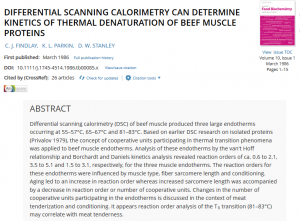Differential scanning calorimetry can determine kinetics of thermal-denaturation of beef muscle proteins
 Differential scanning calorimetry (DSC) of beef muscle produced three large endotherms occurring at 55–57°C, 65–67°C and 81–83°C. Based on earlier DSC research on isolated proteins (Privalov 1979), the concept of cooperative units participating in thermal transition phenomena was applied to beef muscle endotherms. Analysis of these endotherms by the van’t Hoff relationship and Borchardt and Daniels kinetics analysis revealed reaction orders of ca. 0.6 to 2.1, 3.5 to 5.1 and 1.5 to 3.1, respectively, for the three muscle endotherms. The reaction orders for these endotherms were influenced by muscle type, fiber sarcomere length and conditioning. Aging led to an increase in reaction order whereas increased sarcomere length was accompanied by a decrease in reaction order or number of cooperative units. Changes in the number of cooperative units participating in the endotherms is discussed in the context of meat tenderization and conditioning. It appears reaction order analysis of the T3 transition (81–83°C) may correlate with meat tenderness.
Differential scanning calorimetry (DSC) of beef muscle produced three large endotherms occurring at 55–57°C, 65–67°C and 81–83°C. Based on earlier DSC research on isolated proteins (Privalov 1979), the concept of cooperative units participating in thermal transition phenomena was applied to beef muscle endotherms. Analysis of these endotherms by the van’t Hoff relationship and Borchardt and Daniels kinetics analysis revealed reaction orders of ca. 0.6 to 2.1, 3.5 to 5.1 and 1.5 to 3.1, respectively, for the three muscle endotherms. The reaction orders for these endotherms were influenced by muscle type, fiber sarcomere length and conditioning. Aging led to an increase in reaction order whereas increased sarcomere length was accompanied by a decrease in reaction order or number of cooperative units. Changes in the number of cooperative units participating in the endotherms is discussed in the context of meat tenderization and conditioning. It appears reaction order analysis of the T3 transition (81–83°C) may correlate with meat tenderness.
![]()
Findlay, C. J., Parkin, K. L., & Stanley, D. W. (1986). Differential scanning calorimetry can determine kinetics of thermal-denaturation of beef muscle proteins. Journal of Food Biochemistry, 10(1), 1-15. http://dx.doi.org/10.1111/j.1745-4514.1986.tb00085.x